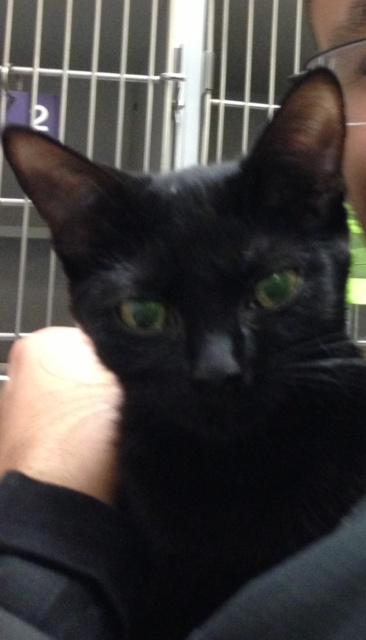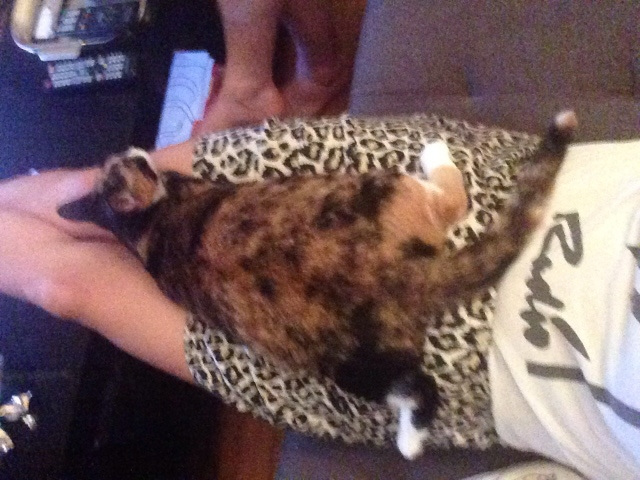QuestionHi,
My 2.5yo male Siamese/Burmese cross (I adopted he and his brother at 2 years of age) has urinary problems. He has been to the vet twice and had blood and bacteria in his urine and aparently his bladder lining/membrane was inflamed (the capacity of his bladder was very small). He was non-obstructed, but is displaying the same symptoms again (straining, frequently passing drops of urine). I am his 3rd family and I feel he was handed back to the Humane Society due to this recurrent problem. He is an overweight cat (was when I got him; we're working on that). His brother does not suffer from it at all and is more active and is a healthy weight. Their diets are the same. My question is, what is the process of elimination for finding out the cause? Can I take him back to the vet and get him tested for absolutely everything (kidney/bladder stones, crystals, bacteria, etc.) with the hope of getting to the root of the problem? What's the best way to proceed with the aim of developing a long-term program that with help us reduce and manage the problem?
AnswerHi Natalie. I've been through the exact same thing with a cat of mine who's now 12. It took literally 3 years and 5 vets to get the final diagnosis, with the last vet being an internal specialist.
When you bring him back to the vet for these symptoms, they might elect to do a cystocentesis. This is where they will collect a urine specimen by inserting a needle directly through his abdomen and into his bladder. It can be done in the office while you wait and is tolerated well, but the cat's bladder must have a reasonable amount of urine in it. If his bladder is empty, you may need to leave him there for a few hours for urine to collect in the bladder.
A cystocentesis is usually preferred over collecting urine in an empty litter box because it's sterile and more accurate for urinalysis. An in-office urine dip test can indicate whether the urinary pH is consistent with a current infection, can detect nitrites and blood cells. However, it would definitely be a good idea to have the urine sent out for a complete urinalysis which would analyze urinary sediment. This is how small urinary tract crystals are diagnosed.
If the tests come back that he has urinary tract crystals, then you have hope that you can manage the problem. Urinary tract crystals are due, in part, to diet. The two most common types of crystals are struvite and calcium oxalate. There are prescription diets for each, and there is even one, Royal Canin's SO, that treats/prevents both. If separating the two cats to eat is a problem, this diet is balanced and may be okay to feed the brother if necessary, but check with the vet.
Sometimes there are no free-floating crystals in the urine, but there are larger stones that have formed. A urinalysis may be negative, but an x-ray may (or may not) show bladder stones. Even though my cat's urine samples were fine, an ultrasound was done on the bladder and kidneys, and four large calcium oxalate stones were found inside the kidneys. When small enough, the cat may pass them on their own, and bladder stones may be removed surgically. As of now, there is no safe way to remove kidney stones in cats.
If it turns out that it is just a urinary tract infection, then there is less to do there, and finding out the underlying cause of an infection is difficult. Make sure he drinks plenty of water, and preferably, feed him more canned food than dry food. You may want to have kidney levels checked. Poor kidney function can lead to high urinary pH, and high urinary pH can lead to urinary tract infections. An abnormality in the urethra or elsewhere in the urinary tract could be causing the bladder not to empty properly (hence, infections), but I think that would take ultrasounds and/or exploratory surgery to discover. You could discuss feeding a food with some cranberry to bring down urinary pH with your vet, which may prevent infection if his urinary pH is too high for some reason. But I would be careful with this, because if his urinary pH goes TOO low, this could cause oxalate stones.
Some cats have neither crystals nor infections but an inflammatory condition called interstitial cystitis, and I'm wondering if this could be the case with your kitty. The mucosal lining of the bladder becomes inflamed and almost separates from the bladder wall. The condition is seen in many animals, including people, and is among the most painful conditions known to man. It causes pain, urgency, blood in the urine, and this leaves the patient wide open to secondary infection. The cause isn't really known, but anxiety or stress may be a factor. There also isn't any agreed upon treatment. Cosequin, a glucosamine/chondroitin supplement for arthritis, is one option. It's available through vets and pet stores and gets mixed into food. Some vets will also give a pain reliever. Some give a non-steroidal anti-inflammatory. It's better than nothing. One of mine gives a morphine-like drug for the first few days during a flare up. After this, he will follow with a medication called amitriptyline (Elavil). This is also widely used in human medicine for the condition. Some vets feel it works while others don't, but as the owner of a cat who struggles with the condition, I have to say this treatment works better than the other methods. Typically, my cat needs the full dose for about 3 weeks, then tapers down and off of the medication over the next three weeks. Many cats will have repeat episodes of this condition throughout life, but in six years, she's only needed treatment twice.

 What breed/mix is my cat?
QuestionSugar and Oliver
QUESTION: Hi,
Im wond
What breed/mix is my cat?
QuestionSugar and Oliver
QUESTION: Hi,
Im wond
 identify breed of cat
Question
Male cat 4 years ol
I recently adopted
identify breed of cat
Question
Male cat 4 years ol
I recently adopted
 Bombay at local pound??!
Question
Wide set eyes Kitten
Hi I have a
Bombay at local pound??!
Question
Wide set eyes Kitten
Hi I have a
 Cat eating too much?
Question
Chickpea
Hello,
Ive attached a photo of
Cat eating too much?
Question
Chickpea
Hello,
Ive attached a photo of
 Cat in Heat with a little blood in her stool
Question
Millie Moo
Hi, I have a 5 month old female kit
Cat in Heat with a little blood in her stool
Question
Millie Moo
Hi, I have a 5 month old female kit